I think that there is an issue with the data and that your prediction might be a little optimistic. To see this, I used the KrigingAlgorithm to get both a value and a confidence interval. Moreover, I plotted the data to get a feeling of the situation.
First, I turned the data into a usable Numpy array:
import openturns as ot
import numpy as np
data = [
732018, 2.501, 95.094,
732018, 3.001, 91.658,
732018, 3.501, 89.164,
732018, 3.751, 88.471,
732018, 4.001, 88.244,
732018, 4.251, 88.53,
732018, 4.501, 89.8,
732018, 4.751, 90.66,
732018, 5.001, 92.429,
732018, 5.251, 94.58,
732018, 5.501, 97.043,
732018, 6.001, 102.64,
732018, 6.501, 108.798,
732079, 2.543, 94.153,
732079, 3.043, 90.666,
732079, 3.543, 88.118,
732079, 3.793, 87.399,
732079, 4.043, 87.152,
732079, 4.293, 87.425,
732079, 4.543, 88.643,
732079, 4.793, 89.551,
732079, 5.043, 91.326,
732079, 5.293, 93.489,
732079, 5.543, 95.964,
732079, 6.043, 101.587,
732079, 6.543, 107.766,
732170, 2.597, 95.394,
732170, 3.097, 91.987,
732170, 3.597, 89.515,
732170, 3.847, 88.83,
732170, 4.097, 88.61,
732170, 4.347, 88.902,
732170, 4.597, 90.131,
732170, 4.847, 91.035,
732170, 5.097, 92.803,
732170, 5.347, 94.953,
732170, 5.597, 97.414,
732170, 6.097, 103.008,
732170, 6.597, 109.164,
732353, 4.685, 91.422,
]
dimension = 3
array = np.array(data)
nrows = len(data) // dimension
ncols = len(data) // nrows
data = array.reshape((nrows, ncols))
Then I created a Sample with the data, scaling a to make the computations simpler.
x = ot.Sample(data[:, [0, 1]])
x[:, 0] /= 1.e5
y = ot.Sample(data[:, [2]])
Creating the kriging metamodel is simple with a ConstantBasisFactory trend and a SquaredExponential covariance model.
inputDimension = 2
basis = ot.ConstantBasisFactory(inputDimension).build()
covarianceModel = ot.SquaredExponential([0.1]*inputDimension, [1.0])
algo = ot.KrigingAlgorithm(x, y, covarianceModel, basis)
algo.run()
result = algo.getResult()
metamodel = result.getMetaModel()
The kriging metamodel can then be used for prediction:
a = 732107 / 1.e5
b = 4.92
inputPrediction = [a, b]
outputPrediction = metamodel([inputPrediction])[0, 0]
print(outputPrediction)
This prints:
95.3261715192566
This does not match your prediction, and has less amplitude than the RBF prediction.
In order to see this more clearly, I created a plot of the data, the metamodel and the point to predict.
graph = metamodel.draw([7.320, 2.0], [7.325,6.597], [50]*2)
cloud = ot.Cloud(x)
graph.add(cloud)
point = ot.Cloud(ot.Sample([inputPrediction]))
point.setColor("red")
graph.add(point)
graph.setXTitle("a")
graph.setYTitle("b")
This produces the following graphics:

You see that there is an outlier on the right: this is the last point in the table. The point which is to predict is in red in the upper left of the graphics. In the neighborhood of this point, from left to right, we see that the kriging increase from 92 to 95, then decreases again. This is generated by much high values (close to 100) in the upper part of the domain.
I then compute a confidence interval of the kriging prediction.
conditionalVariance = result.getConditionalMarginalVariance(
inputPrediction)
sigma = np.sqrt(conditionalVariance)
[outputPrediction - 2 * sigma, outputPrediction + 2 * sigma]
This produces:
[84.26731758315441, 106.3850254553588]
Hence, your prediction 90.79 is contained in the 95% confidence interval, but with a rather high uncertainty.
From this, I would say that the cubic RBF exaggerates the changes in the data, leading to a rather high value.

